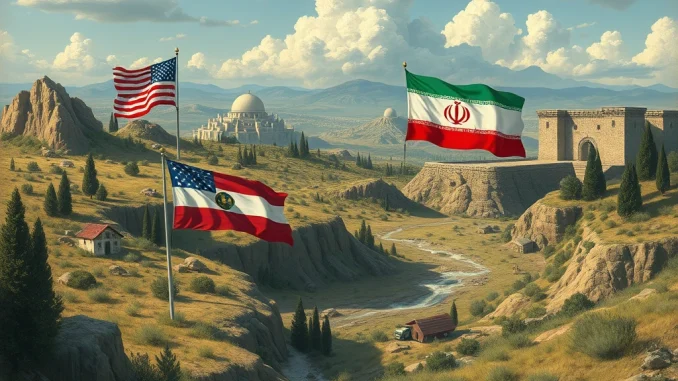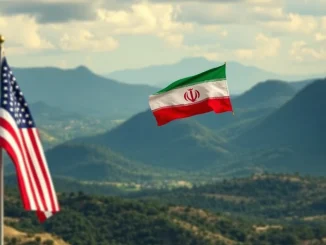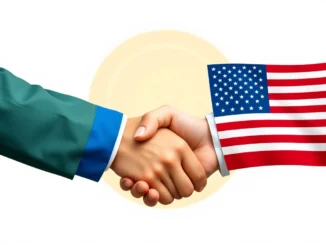
Hey there, market watchers! While our focus is often on the fast-paced world of cryptocurrencies, global geopolitical events can significantly influence market sentiment and volatility across the board. Today, we’re looking at a development in the Middle East that’s capturing attention, particularly on platforms designed to gauge future outcomes. The potential for a renewed US Iran Nuclear Deal is back in the spotlight, with prediction markets offering intriguing insights into the perceived likelihood.
Prediction Market Kalshi Gauges US Iran Nuclear Deal Odds
According to reports, the odds for a US Iran Nuclear Deal being struck within a certain timeframe have recently shifted. Prediction market platform Kalshi is currently showing a 44% chance of an agreement. These platforms aggregate the beliefs of participants who stake money on the outcome of real-world events, providing a unique, market-driven perspective on probabilities.
What does a 44% chance signal? It suggests significant uncertainty. It’s far from a guaranteed outcome (like 80% or 90%), but also not considered highly improbable (like 10% or 20%). It places the potential deal squarely in ‘maybe’ territory, reflecting the complex and volatile nature of the negotiations.
Signals Amidst Geopolitical Tensions
The reported shift in odds comes amid conflicting signals from the region. On one hand, there are indications of potential de-escalation. Iran has reportedly signaled a willingness to resume talks, provided the U.S. refrains from interference in its internal affairs. This conditional openness suggests a potential path back to the negotiating table after a period of stalled diplomacy.
Adding to the diplomatic efforts, Arab intermediaries are reportedly playing a role, facilitating communication and potentially bridging gaps between the parties. Such back-channel diplomacy is often crucial in complex international relations.
However, these positive signals are juxtaposed with ongoing conflict. Israel continues to conduct airstrikes in the region, highlighting that despite diplomatic overtures, significant Geopolitical Tensions persist. This dynamic environment makes predicting outcomes incredibly difficult, which is precisely where prediction markets like Kalshi find their purpose.
Understanding the Context: The Nuclear Deal
To appreciate the significance, it helps to understand the background. The original agreement, known as the Joint Comprehensive Plan of Action (JCPOA), was struck in 2015 between Iran and several world powers, including the U.S. It aimed to limit Iran’s nuclear program in exchange for sanctions relief. The U.S. withdrew from the deal in 2018, reimposing sanctions, and tensions have been high since.
A return to the deal could have wide-ranging implications:
- **Potential Benefits:** Reduced risk of nuclear proliferation, decreased regional conflict potential, possible increase in Iranian oil exports.
- **Potential Challenges:** Verification issues, distrust between parties, impact on regional adversaries, domestic political opposition in the U.S. and Iran.
Impact on Middle East Stability and Beyond
The potential for a renewed agreement, or the lack thereof, directly impacts Middle East Stability. A deal could potentially ease some regional friction, while failure could escalate tensions further. The involvement of Arab intermediaries underscores the regional stake in the outcome.
Geopolitical stability, or the lack of it, is a key factor watched by global markets. Increased stability is generally viewed positively, while rising tensions can lead to uncertainty and risk aversion.
Oil Market Reaction: A Tangible Example
One immediate and tangible market reaction noted in the reports was the movement in oil prices. As signals of potential de-escalation emerged, oil prices reportedly fell. Why?
A key consequence of a renewed nuclear deal could be the lifting of sanctions on Iran’s oil exports. More Iranian oil entering the global market would increase supply, potentially lowering prices. The mere *possibility* of this happening can influence traders’ expectations and impact prices even before a deal is finalized.
This Oil Market Reaction serves as a clear example of how geopolitical developments translate directly into market movements. While the connection to crypto isn’t direct in this specific report, traders in volatile markets like crypto often monitor these broader macroeconomic and geopolitical signals as indicators of overall market sentiment and potential volatility.
Looking Ahead
The 44% odds on Prediction Market Kalshi reflect a complex reality: the path to a renewed US Iran Nuclear Deal is uncertain and fraught with challenges, yet diplomatic windows occasionally open. The interplay between de-escalation signals, ongoing regional conflict, and the involvement of intermediaries paints a picture of delicate, high-stakes diplomacy.
Market participants, whether focused on oil, traditional stocks, or digital assets, will continue to watch these developments closely. Geopolitical events remain a significant factor influencing global markets, reminding us that everything is connected in the intricate world of finance and international relations.
Compelling Summary
In summary, the fluctuating odds on prediction markets like Kalshi highlight the persistent uncertainty surrounding a potential US Iran Nuclear Deal. Despite signals of a willingness to talk from Iran and the efforts of Arab intermediaries, deep-seated Geopolitical Tensions and regional conflicts like Israeli airstrikes continue. This delicate balance impacts not only Middle East Stability but also global markets, as seen in the recent Oil Market Reaction. As the situation evolves, the 44% chance serves as a stark reminder that while diplomacy is active, the outcome remains far from certain, keeping markets on edge.



